Egypt to Argentina Is A Long Way In my last update we had just spent our first evening in Luxor. As it turned out we only drove past the Luxor Temple which was quite impressive when all lit up but we did not stop for photos. Maybe we would get another chance to go on our own the next night. The next morning we went to the Valley of the Kings. The Valley of the Kings is a place where many of the Kings built their burial chambers and were entombed. Many of these were discovered in the 19th and early 20th centuries. Perhaps the most famous discovery was the tomb of King Tutankhamen discovered by Howard Carter in 1921. It was so important because it was found virtually undisturbed which helped to fill in a lot of unknown information about the burial and mummification processes. Even still, it was not the most impressive of tombs because he died so young and it was built after his death. There are 11 tombs that can be visited in total but more than 60 there. Your ticket allows you to go into 3 but you can always buy another ticket if you want to go into more. King Tut is a separate ticket all together (100 Egyptian Pounds or about $16) as well as the tombs of King Ramses V and VI is another ticket 50 pounds). We did them both because we wanted every possible experience we could get. The rest of our group picked one or the other. Map of all of the tombs 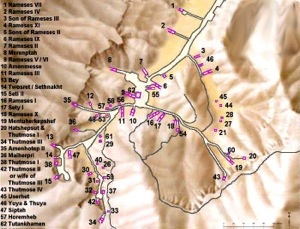 Dino, our guide, chose the three four us to see as a group. He was not allowed to go with us inside. However, he gave us information using pictures he borrowed from a vendor. So when we did go inside each we were able to see it for ourselves. The vendor allowed him to use the pictures because after we left Dino asked us if we were interested in buying the pics from the vendor. You are not even allowed to bring your camera into the Valley of the Kings. I hate that and I am not sure why. They do not take away cell phones so people snuck photos using their phones. If they do not want flash photography then say that. They think, I believe, that more people will come to see it for themselves if they do not see pictures. I think it would be the opposite for me. If I see the pics I would say oh man I want to see that for myself… Not, well I saw so and so’s pictures now I don’t have to go myself… In my humble opinion! Besides the guards shake you down for money to allow you to take pictures with your phone. The shakedown is a worse experience more of a deterrent than seeing photos would be. We went into the tomb of King Ramses III. He was the son of perhaps the most famous of all the kings. Our tour was named the King Ramses II tour and it is one of the most comprehensive tours of Egypt that On The Go Tours offers. He is sometimes known as Ramses the Great. Unfortunately, the tomb of Ramses II is not as well preserved as that of Ramses III. The tomb of Ramses III is sometimes known as Harper’s Tomb because of an image of a blind harpist on one of the walls. King Ramses III
Dino, our guide, chose the three four us to see as a group. He was not allowed to go with us inside. However, he gave us information using pictures he borrowed from a vendor. So when we did go inside each we were able to see it for ourselves. The vendor allowed him to use the pictures because after we left Dino asked us if we were interested in buying the pics from the vendor. You are not even allowed to bring your camera into the Valley of the Kings. I hate that and I am not sure why. They do not take away cell phones so people snuck photos using their phones. If they do not want flash photography then say that. They think, I believe, that more people will come to see it for themselves if they do not see pictures. I think it would be the opposite for me. If I see the pics I would say oh man I want to see that for myself… Not, well I saw so and so’s pictures now I don’t have to go myself… In my humble opinion! Besides the guards shake you down for money to allow you to take pictures with your phone. The shakedown is a worse experience more of a deterrent than seeing photos would be. We went into the tomb of King Ramses III. He was the son of perhaps the most famous of all the kings. Our tour was named the King Ramses II tour and it is one of the most comprehensive tours of Egypt that On The Go Tours offers. He is sometimes known as Ramses the Great. Unfortunately, the tomb of Ramses II is not as well preserved as that of Ramses III. The tomb of Ramses III is sometimes known as Harper’s Tomb because of an image of a blind harpist on one of the walls. King Ramses III 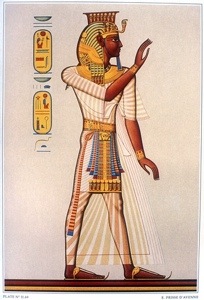 One of the amazingly preserved images
One of the amazingly preserved images  Perhaps the most impressive parts of the whole tomb is the annex. The hieroglyphics on the wall are so well preserved. As you descend the slanted stairway down towards the tomb you pass through a room that you are not supposed to be able to enter. The annex is adorned with images depicting stories related to the Book of Gates. At the time they believed that the King would have to pass through a series of gates with tasks or tests at each one. As they completed the tests they would be permitted to pass to the next one and eventually to the afterlife. The Annex
Perhaps the most impressive parts of the whole tomb is the annex. The hieroglyphics on the wall are so well preserved. As you descend the slanted stairway down towards the tomb you pass through a room that you are not supposed to be able to enter. The annex is adorned with images depicting stories related to the Book of Gates. At the time they believed that the King would have to pass through a series of gates with tasks or tests at each one. As they completed the tests they would be permitted to pass to the next one and eventually to the afterlife. The Annex  However, the guard shakes you down for some money to go around it and into a back room. In a normal tourism year, this place would be packed. There were people there but quite often we had the place to ourselves… Another good reason that now is a great time to come! No lines and best chances to get pics without other lookie-loos in them. We paid the guard five pounds each and went in. So many of the places we had seen so far had artwork and hieroglyphics that had no colour left that it was hard to get the true idea of how it had looked. This tomb however was very well preserved. I think this has a lot to do with the dry atmosphere and it’s removal from light. The burial chamber is quite amazing. The ceiling painting is very well preserved. In this case, and in several, the ceiling portrays an image of The goddess Nut. Her arms and legs wrap around the entire ceiling with one side depicting day and the other depicting night. The burial chamber
However, the guard shakes you down for some money to go around it and into a back room. In a normal tourism year, this place would be packed. There were people there but quite often we had the place to ourselves… Another good reason that now is a great time to come! No lines and best chances to get pics without other lookie-loos in them. We paid the guard five pounds each and went in. So many of the places we had seen so far had artwork and hieroglyphics that had no colour left that it was hard to get the true idea of how it had looked. This tomb however was very well preserved. I think this has a lot to do with the dry atmosphere and it’s removal from light. The burial chamber is quite amazing. The ceiling painting is very well preserved. In this case, and in several, the ceiling portrays an image of The goddess Nut. Her arms and legs wrap around the entire ceiling with one side depicting day and the other depicting night. The burial chamber  The next tomb we went to was that of Merenptah. Again you descend a very long hallway, passing through a room depicting the Book of Gates. This tomb is very well preserved as well. Unlike Ramses III however, there is a sarcophagus in this one. Map of the Tomb
The next tomb we went to was that of Merenptah. Again you descend a very long hallway, passing through a room depicting the Book of Gates. This tomb is very well preserved as well. Unlike Ramses III however, there is a sarcophagus in this one. Map of the Tomb  An image of Merenptah with the god Horus (falcon)
An image of Merenptah with the god Horus (falcon)  The long passageway
The long passageway 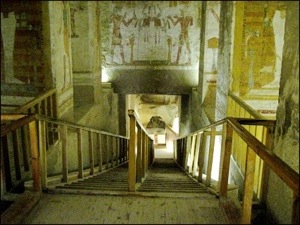 Many tombs depict boats transporting the King in the afterlife
Many tombs depict boats transporting the King in the afterlife  When you get to the burial chamber you can see some of the inner sarcophagi. To help understand what that means, imagine a coffin being placed inside another coffin inside another coffin inside a box inside another box. The outer most boxes are often made of granite or limestone. It is these boxes that are still in some cases left on display at the Valley of the Kings. The rest is in the museum in Cairo. You need to go to both places to get the full experiences. The sarcophagus of Merenptah…One of the sarcophagi of Merenptah
When you get to the burial chamber you can see some of the inner sarcophagi. To help understand what that means, imagine a coffin being placed inside another coffin inside another coffin inside a box inside another box. The outer most boxes are often made of granite or limestone. It is these boxes that are still in some cases left on display at the Valley of the Kings. The rest is in the museum in Cairo. You need to go to both places to get the full experiences. The sarcophagus of Merenptah…One of the sarcophagi of Merenptah 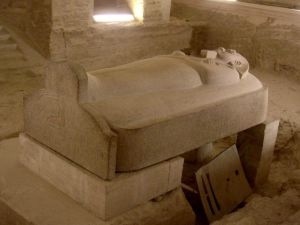
 Next we used our extra ticket to go into the King Ramses V and VI tombs. Again they are very well preserved. It is believed that Ramses VI must have died suddenly after Ramses V because his tomb is built as an extension of Ramses V’s tomb. There must not have been a lot of time to build his own. You pass through the tomb of V and descend a little further into VI’s. The ceiling again depicts the goddess Nut (pronounced noot). This one is exceptionally well preserved. The burial chamber of VI
Next we used our extra ticket to go into the King Ramses V and VI tombs. Again they are very well preserved. It is believed that Ramses VI must have died suddenly after Ramses V because his tomb is built as an extension of Ramses V’s tomb. There must not have been a lot of time to build his own. You pass through the tomb of V and descend a little further into VI’s. The ceiling again depicts the goddess Nut (pronounced noot). This one is exceptionally well preserved. The burial chamber of VI  The heads are on the left middle. The backs of the two goddesses meet in the middle. The legs are in the right corners and the arms reach above the heads.
The heads are on the left middle. The backs of the two goddesses meet in the middle. The legs are in the right corners and the arms reach above the heads. 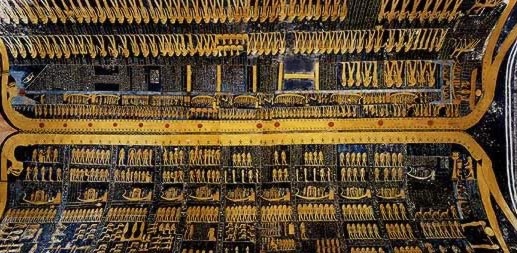 After these tombs, we went to the tomb of Tutankhamen. We were warned that it was not to exciting. It was quite simple actually. I felt like I could not come all this way and not see it. King Tut became King at 9 years old. His predecessor who may or may not have been his father kept him and another young boy as his princes. Tut became King after his father’s death. He died at somewhere between 18 and 21. It was not expected and so his tomb was built in 70 days after his death. There are different theories about his death but it seems he died of an illness. Inside his tomb there are four rooms at the end of a short passageway. Howard Carter discovered the entry to the tomb accidentally. When he got inside, he was disappointed to find only one room. He noticed however that there were statues of guards (Tut himself statues) in front of a wall. He began tapping the wall and it sounded hollow. When they removed the wall, it revealed the burial chamber. Now on display is a replica of one of the inner sarcophagi and a replica of the golden coffin. The originals are in the Cairo Museum. On one wall are images of twelve baboons that represent 12 hours and 12 months. Replica of Inner Sarcophagus is on display now
After these tombs, we went to the tomb of Tutankhamen. We were warned that it was not to exciting. It was quite simple actually. I felt like I could not come all this way and not see it. King Tut became King at 9 years old. His predecessor who may or may not have been his father kept him and another young boy as his princes. Tut became King after his father’s death. He died at somewhere between 18 and 21. It was not expected and so his tomb was built in 70 days after his death. There are different theories about his death but it seems he died of an illness. Inside his tomb there are four rooms at the end of a short passageway. Howard Carter discovered the entry to the tomb accidentally. When he got inside, he was disappointed to find only one room. He noticed however that there were statues of guards (Tut himself statues) in front of a wall. He began tapping the wall and it sounded hollow. When they removed the wall, it revealed the burial chamber. Now on display is a replica of one of the inner sarcophagi and a replica of the golden coffin. The originals are in the Cairo Museum. On one wall are images of twelve baboons that represent 12 hours and 12 months. Replica of Inner Sarcophagus is on display now  Baboons in burial chamber
Baboons in burial chamber  Before you actually get to the burial chamber, on display in the antechamber is the actual mummy of King Tut. It is encased in a special glass case. I suppose this is what you are paying extra to see. All of the other mummies are in the Cairo museum. The bodies are always covered but the head and feet usually revealed. This may be due to the decay of the body or out of respect. King Tut
Before you actually get to the burial chamber, on display in the antechamber is the actual mummy of King Tut. It is encased in a special glass case. I suppose this is what you are paying extra to see. All of the other mummies are in the Cairo museum. The bodies are always covered but the head and feet usually revealed. This may be due to the decay of the body or out of respect. King Tut  The final tomb we visited as a group was that of Ramses IV. It is quite a bit different than the others. It is a long corridor and the annexes are all built in a straight line rather than as lateral rooms. What is interesting about this tomb is some of the graffiti in it. Specifically, Christian graffiti that is millennia old. The mummy of Ramses IV was not found here as is the case with many of the tombs. At some point in antiquity, protectors of the kings relocated many of the kings to protect them from grave robbers. DNA testing has proven that this is indeed the mummy of Ramses IV and the cartouches and hieroglyphics on the wall indicate that this is his tomb. After leaving the Valley of the Kings, we headed to Deir El-Bahri. This is a temple on the other side of the Temple of the Kings. It was built by Queen Hatshepsut. It is a series of colonnades and is actually the site of three temples. Hatshepsut was the daughter of Thutmose I. She learned how to rule during his reign however when he had a son with another wife he should be king eventually. However, when Thutmose I died she assumed the reign because her half brother was too young and unprepared. She ruled as a King not a queen. She dressed as a man and is portrayed as a man on the temple art. Deir El-Bahri
The final tomb we visited as a group was that of Ramses IV. It is quite a bit different than the others. It is a long corridor and the annexes are all built in a straight line rather than as lateral rooms. What is interesting about this tomb is some of the graffiti in it. Specifically, Christian graffiti that is millennia old. The mummy of Ramses IV was not found here as is the case with many of the tombs. At some point in antiquity, protectors of the kings relocated many of the kings to protect them from grave robbers. DNA testing has proven that this is indeed the mummy of Ramses IV and the cartouches and hieroglyphics on the wall indicate that this is his tomb. After leaving the Valley of the Kings, we headed to Deir El-Bahri. This is a temple on the other side of the Temple of the Kings. It was built by Queen Hatshepsut. It is a series of colonnades and is actually the site of three temples. Hatshepsut was the daughter of Thutmose I. She learned how to rule during his reign however when he had a son with another wife he should be king eventually. However, when Thutmose I died she assumed the reign because her half brother was too young and unprepared. She ruled as a King not a queen. She dressed as a man and is portrayed as a man on the temple art. Deir El-Bahri  Later her brother Thutmose II killed her and took the reign. He erased all artwork of her from the temple except for one image. You can see female facial features on a male body. The only remaining image of Hatshepsut
Later her brother Thutmose II killed her and took the reign. He erased all artwork of her from the temple except for one image. You can see female facial features on a male body. The only remaining image of Hatshepsut 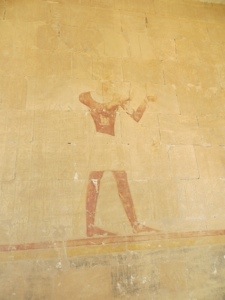 I was interviewed by a television station at the temple. I met a guy in our hotel in Luxor who turned out to be the cameraman. They were doing interviews at the temple and I chatted with him again there. The on air personality was a woman and she asked if she could interview me. She asked about my experience in Egypt and if I would encourage others to come. My interview
I was interviewed by a television station at the temple. I met a guy in our hotel in Luxor who turned out to be the cameraman. They were doing interviews at the temple and I chatted with him again there. The on air personality was a woman and she asked if she could interview me. She asked about my experience in Egypt and if I would encourage others to come. My interview  Thutmose II
Thutmose II  My cameraman buddy
My cameraman buddy  Our final scheduled stop for the day was at the Karnak Temple. It is actually a complex of temples that were built over time. It dates back to 3200 BC. It was very busy with Egyptians as it is seen as a religious site to locals. It is basically an open air museum. Karnak Temple
Our final scheduled stop for the day was at the Karnak Temple. It is actually a complex of temples that were built over time. It dates back to 3200 BC. It was very busy with Egyptians as it is seen as a religious site to locals. It is basically an open air museum. Karnak Temple  Rams with kings under their chins line the entrance
Rams with kings under their chins line the entrance  The columns in the main complex. The obelisk is one of four left in Egypt
The columns in the main complex. The obelisk is one of four left in Egypt  Our tour group: (L to R) Dino, Eliza, Jane, Megan, Me, Nic, Daeger (James), T-Bone (Todd)
Our tour group: (L to R) Dino, Eliza, Jane, Megan, Me, Nic, Daeger (James), T-Bone (Todd)  You are supposed to make a wish and then walk 7 times around this scarab alter… Counterclockwise. Eliza and Megan do it here… Wonder if their wish came true?
You are supposed to make a wish and then walk 7 times around this scarab alter… Counterclockwise. Eliza and Megan do it here… Wonder if their wish came true?  On the way back to our hotel, Nicola and I asked to be dropped off at the Luxor Temple. We wanted to see it at night and decided to go on our own. It was very cool to see the temple lit up at night. While we did not have a guide one offered to let us join his group. We didn’t but it was nice that he offered. The temple used to be connected by a long street to the Karnak Temple lined with sphinx statues. They were all lost or taken over many eons but they have been collecting them back. They hope to recreate the street someday. The entrance to the Luxor Temple used to have two obelisks flanking each side. Today only one remains. The other one is in Paris at Place de la Concorde. Luxor Temple Entrance
On the way back to our hotel, Nicola and I asked to be dropped off at the Luxor Temple. We wanted to see it at night and decided to go on our own. It was very cool to see the temple lit up at night. While we did not have a guide one offered to let us join his group. We didn’t but it was nice that he offered. The temple used to be connected by a long street to the Karnak Temple lined with sphinx statues. They were all lost or taken over many eons but they have been collecting them back. They hope to recreate the street someday. The entrance to the Luxor Temple used to have two obelisks flanking each side. Today only one remains. The other one is in Paris at Place de la Concorde. Luxor Temple Entrance  A little spooky but very cool
A little spooky but very cool  The statues by night
The statues by night 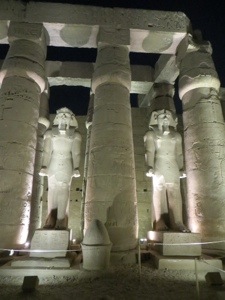 Sitting Ramses II Colossus
Sitting Ramses II Colossus  Amazingly preserved
Amazingly preserved  The sphinxes
The sphinxes  From the Luxor Temple we walked back to our hotel. It took about 20 minutes. The group all then went for dinner together at an Irish pub across the street from our hotel. The only thing Irish about it was the name. We were the only customers. It was dead… A definite sign of the struggling tourism situation in Egypt. The next day we drove to Hurghada which took about four hours. It actually flew by because we had wifi in the van. Hurghada is on the Red Sea. It is a resort town. 35 years ago there was next to nothing here. It was built up to be resort town filled with all-inclusive resorts. We were only booked as Hal board which included breakfast and dinner. For $8 each per day we upgraded to all-inclusive which allowed us lunch and all beverages. The resort, and the all the other resorts as well, was filled with Russian tourists. The signs are in Arabic, Russian and English. The staff speak more Russian than English. We were only here to relax. Our room overlooked the Red Sea. We hung-out a lot with our group: Todd, James, Jane and Dino (the other two left from Luxor). We played a lot of Beans and Asshole. On one day we all agreed to hire a boat for a day. We went snorkelling and fishing. Nobody caught any fish except for the crew. They cooked the fish and we had that with the lunch on the boat. We also stopped at an island and relaxed on the beach for an hour. Nicola and I made a sand pyramid and Sphinx. When in Egypt one does not make sand castles. Each night there was a show at the resort. We went a couple of times in the four nights we were there. Relaxing on our boat cruise
From the Luxor Temple we walked back to our hotel. It took about 20 minutes. The group all then went for dinner together at an Irish pub across the street from our hotel. The only thing Irish about it was the name. We were the only customers. It was dead… A definite sign of the struggling tourism situation in Egypt. The next day we drove to Hurghada which took about four hours. It actually flew by because we had wifi in the van. Hurghada is on the Red Sea. It is a resort town. 35 years ago there was next to nothing here. It was built up to be resort town filled with all-inclusive resorts. We were only booked as Hal board which included breakfast and dinner. For $8 each per day we upgraded to all-inclusive which allowed us lunch and all beverages. The resort, and the all the other resorts as well, was filled with Russian tourists. The signs are in Arabic, Russian and English. The staff speak more Russian than English. We were only here to relax. Our room overlooked the Red Sea. We hung-out a lot with our group: Todd, James, Jane and Dino (the other two left from Luxor). We played a lot of Beans and Asshole. On one day we all agreed to hire a boat for a day. We went snorkelling and fishing. Nobody caught any fish except for the crew. They cooked the fish and we had that with the lunch on the boat. We also stopped at an island and relaxed on the beach for an hour. Nicola and I made a sand pyramid and Sphinx. When in Egypt one does not make sand castles. Each night there was a show at the resort. We went a couple of times in the four nights we were there. Relaxing on our boat cruise  One of the crew was creative with towel headwear
One of the crew was creative with towel headwear  I’m the King of the world
I’m the King of the world  Sand Pyramid and Sphinx
Sand Pyramid and Sphinx  A whirling dervish show just like we saw in Dubai
A whirling dervish show just like we saw in Dubai  After Hurghada we drove back to Cairo which took about five or six hours. Back in Cairo we checked into a different hotel in Giza than the first few days. It was a very nice hotel but I would much prefer a lower standard hotel that offered free wifi. The wifi at this place was terribly expensive. We were here for two nights before our flight. Our last full day in Egypt was in Cairo. We went to the Cairo Museum and to the market. The traffic was pretty bad and it took us a long time to get there. The museum is right in Tahrir Square where all the incidents have happened in the last three years. Just a week ago there were four bombs that went off in Cairo and about 30 people were killed. That was on a Friday and most things happen on Fridays. This day was Thursday so nothing was expected. Nevertheless, the street in front of the museum was lined with tanks and armoured vehicles manned and ready for action should anything happen. You can see how close they are
After Hurghada we drove back to Cairo which took about five or six hours. Back in Cairo we checked into a different hotel in Giza than the first few days. It was a very nice hotel but I would much prefer a lower standard hotel that offered free wifi. The wifi at this place was terribly expensive. We were here for two nights before our flight. Our last full day in Egypt was in Cairo. We went to the Cairo Museum and to the market. The traffic was pretty bad and it took us a long time to get there. The museum is right in Tahrir Square where all the incidents have happened in the last three years. Just a week ago there were four bombs that went off in Cairo and about 30 people were killed. That was on a Friday and most things happen on Fridays. This day was Thursday so nothing was expected. Nevertheless, the street in front of the museum was lined with tanks and armoured vehicles manned and ready for action should anything happen. You can see how close they are  The museum was a great way to finish our visit to Egypt. We got to see the things that Dino told us about throughout our visit. For example, we saw all of the riches from King Tutankhamen’s tomb. We saw the golden mask that has become the famous symbol of Egypt that everyone recognizes. We also saw all of the caskets and sarcophagi from his tomb. It is all there for viewing. We also saw things from other tombs and temples as well. We only saw a replica of the Rosetta Stone however. The original is in (you may have guessed)… the British Museum in London. The Cairo Museum (unfortunately you cannot take photos in here either)
The museum was a great way to finish our visit to Egypt. We got to see the things that Dino told us about throughout our visit. For example, we saw all of the riches from King Tutankhamen’s tomb. We saw the golden mask that has become the famous symbol of Egypt that everyone recognizes. We also saw all of the caskets and sarcophagi from his tomb. It is all there for viewing. We also saw things from other tombs and temples as well. We only saw a replica of the Rosetta Stone however. The original is in (you may have guessed)… the British Museum in London. The Cairo Museum (unfortunately you cannot take photos in here either)  The building in the background has been like this for three years. It was the headquarters of the government at the time if I understood that correctly
The building in the background has been like this for three years. It was the headquarters of the government at the time if I understood that correctly  We paid extra for a mummy room ticket. In the mummy room we saw the mummies do all the famous kings. Most notably we saw the mummies of Ramses II, Hatshepsut, Thutmose I and II. There were so many more. You may be wondering what they look like. Each mummy is preserved a little differently depending on the methods used at the time. They are not wrapped like you might see in a horror movie although we did see a couple like that. These however have mostly been unwrapped. Some of them had red and blonde hair. This was caused by the different chemicals they used. Their skin is basically black or very dark. All fluids were drained from the body and all internal organs removed except for the heart. The brain was removed through the nose and the other organs in the abdomen removed through an incision. The body was stuffed with different things to keep it looking as normal as possible. Next we went to the market. We had an hour to wander around on our own. It is always an interesting experience to go to markets. Vendors are always entertaining as they try to lure you in. Especially now with so few tourists they are dying for business. The only thing we bought was a papyrus picture. We bought one of the Eye of Horus. It is supposed to symbolize protection and good luck. It is pretty neat. Back at the hotel we went to bed early. We said our good byes to the group before turning in by 9pm. We had a 4am flight and so we were picked up at 1am to go to the airport. Once again we were amazed at the level of service we were provided at the airport. Achmed from On The Go basically walked us through everything and left us just as we entered through security. Amazing service. We flew to Istanbul from Cairo. Then we flew from Istanbul to Sao Paolo, Brazil and finally to Buenos Aires. All tolled it was a 30 hour journey. We always knew this would be one of our toughest flights but just had to get through it. I will provide another update from South America in a week or so. For now I will leave it with… 5 continents, 20 countries, 20000km, this is our Amazing Race! Note: Since several places did not allow photos, I added some that I did not take myself.
We paid extra for a mummy room ticket. In the mummy room we saw the mummies do all the famous kings. Most notably we saw the mummies of Ramses II, Hatshepsut, Thutmose I and II. There were so many more. You may be wondering what they look like. Each mummy is preserved a little differently depending on the methods used at the time. They are not wrapped like you might see in a horror movie although we did see a couple like that. These however have mostly been unwrapped. Some of them had red and blonde hair. This was caused by the different chemicals they used. Their skin is basically black or very dark. All fluids were drained from the body and all internal organs removed except for the heart. The brain was removed through the nose and the other organs in the abdomen removed through an incision. The body was stuffed with different things to keep it looking as normal as possible. Next we went to the market. We had an hour to wander around on our own. It is always an interesting experience to go to markets. Vendors are always entertaining as they try to lure you in. Especially now with so few tourists they are dying for business. The only thing we bought was a papyrus picture. We bought one of the Eye of Horus. It is supposed to symbolize protection and good luck. It is pretty neat. Back at the hotel we went to bed early. We said our good byes to the group before turning in by 9pm. We had a 4am flight and so we were picked up at 1am to go to the airport. Once again we were amazed at the level of service we were provided at the airport. Achmed from On The Go basically walked us through everything and left us just as we entered through security. Amazing service. We flew to Istanbul from Cairo. Then we flew from Istanbul to Sao Paolo, Brazil and finally to Buenos Aires. All tolled it was a 30 hour journey. We always knew this would be one of our toughest flights but just had to get through it. I will provide another update from South America in a week or so. For now I will leave it with… 5 continents, 20 countries, 20000km, this is our Amazing Race! Note: Since several places did not allow photos, I added some that I did not take myself.
